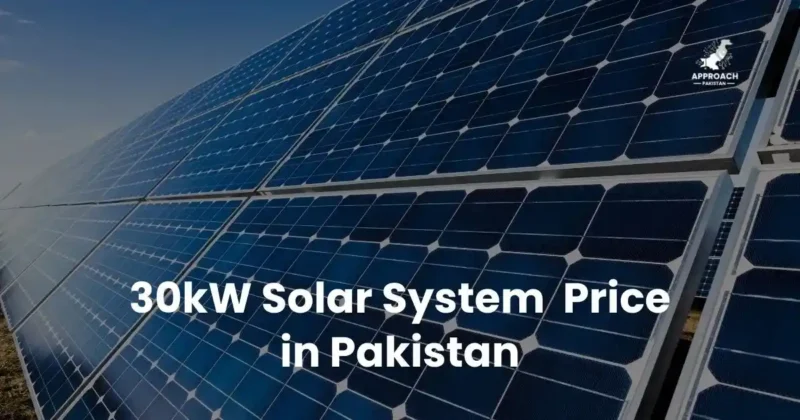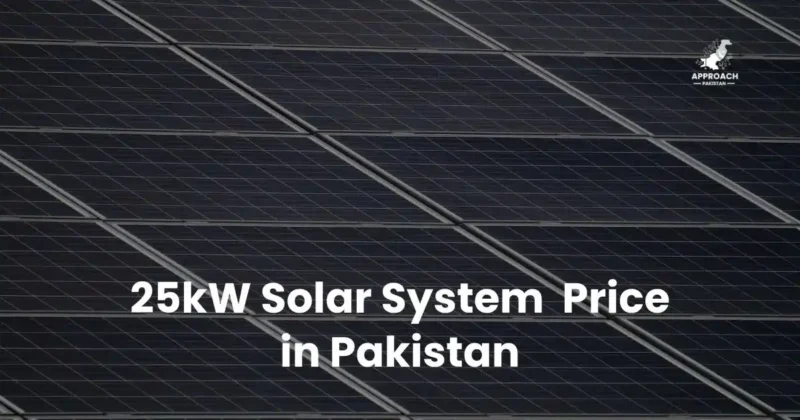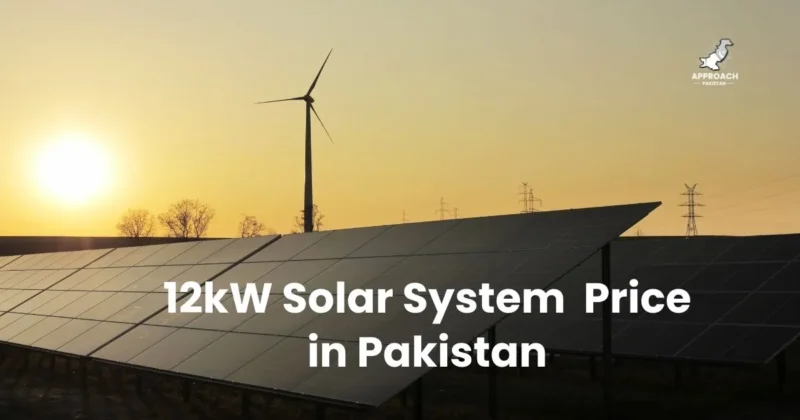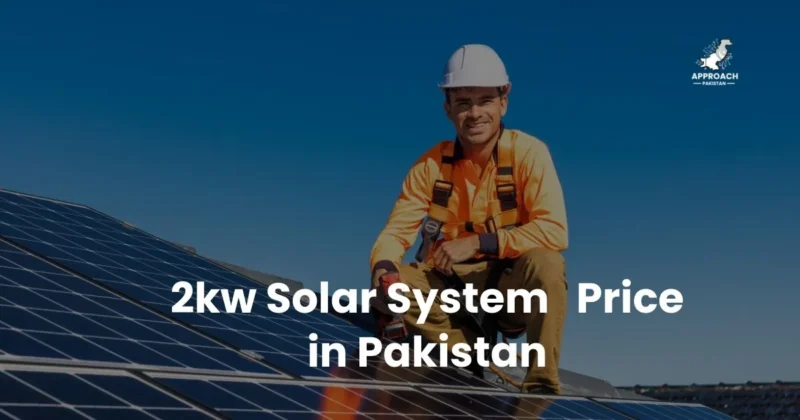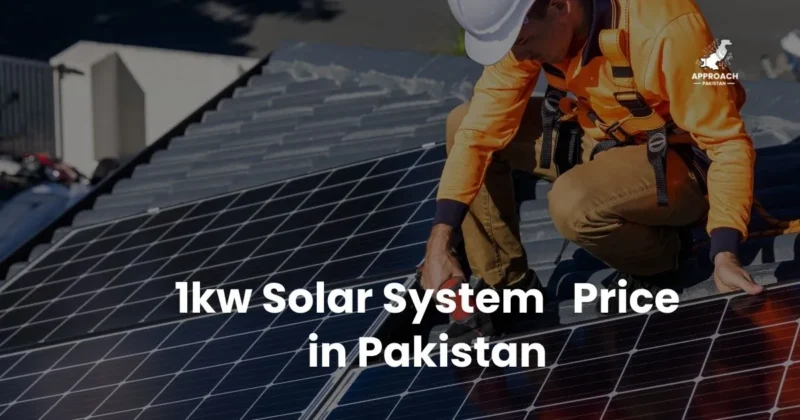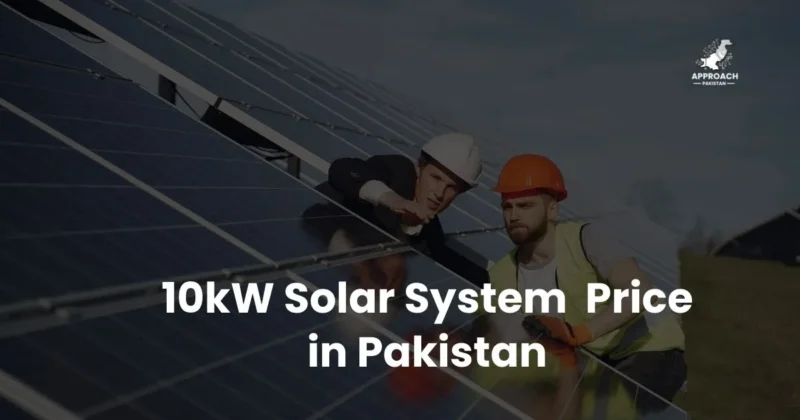4kW Solar Systems Price in Pakistan | Rates & ROI 2025
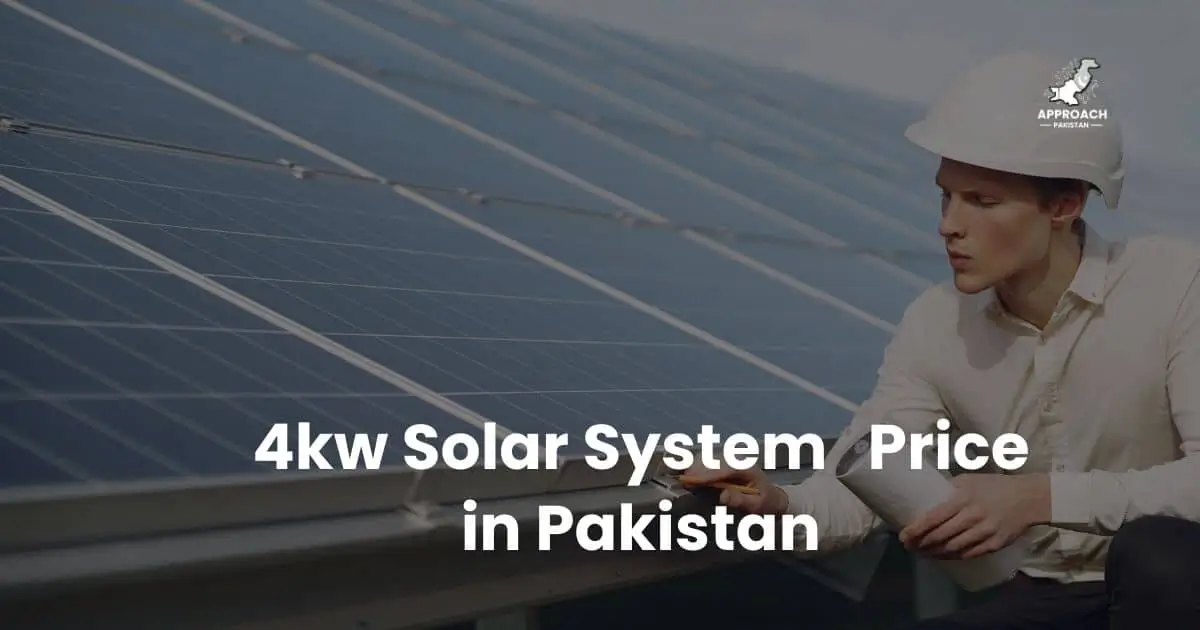
A 4kW solar system in Pakistan costs between PKR 350,000 to 500,000 depending on the type – with on-grid systems starting from PKR 350,000, hybrid systems around PKR 400,000, and off-grid systems reaching PKR 500,000. These systems can power most home appliances and reduce electricity bills by 70-80%.
Tired of electricity bills that drain your monthly budget? You’re not alone. Pakistani families face mounting pressure from rising energy costs and unpredictable power outages that disrupt daily life.
The solution lies in solar energy. A 4kW solar system offers the sweet spot for most Pakistani homes – enough power to run essential appliances while keeping costs manageable.
Introduction: 4kW Solar System in Pakistan
1.1 What is a 4kW Solar System?
A 4kW solar system generates 4,000 watts of power under peak sunlight conditions. It typically includes 12-16 solar panels, producing 16-20 units of electricity daily in Pakistan’s climate.
This system size represents the most popular choice for Pakistani homeowners. It strikes the perfect balance between power generation and investment cost.
The “4kW” refers to peak power output under ideal conditions. In Pakistan’s sunny climate, you’ll get excellent performance year-round.
1.2 Why Choose 4kW for Pakistani Homes?
Pakistani homes consume an average of 300-500 units monthly. A 4kW system generates 480-600 units, making it ideal for most families.
This capacity covers essential appliances without oversizing. You’ll power lights, fans, refrigerator, washing machine, and even a 1.5-ton air conditioner.
The system pays for itself within 3-4 years through electricity savings. For smaller homes with lower consumption, our 1kW solar system price in Pakistan guide shows the most economical solar solution for basic power needs.
1.3 Current Market Overview 2025
The Pakistani solar market has matured significantly. Component prices have stabilized, and installation quality has improved across the board.
Government policies favor solar adoption. Net metering allows you to sell excess power back to the grid, maximizing your investment returns.
Competition among suppliers benefits customers. You’ll find competitive pricing and better service standards than ever before.
4kW Solar System Pricing in Pakistan
2.1 Complete Price Breakdown 2025
Understanding cost components helps you make informed decisions. Here’s what you’ll pay for each system element.
Quality components cost more upfront but deliver better long-term value. Cheap alternatives often fail prematurely, costing more eventually.
For homes with lower electricity consumption considering smaller options, explore our comprehensive 3kW solar system price in Pakistan to understand which capacity best matches your energy needs.
2.1.1 Solar Panel Costs
Solar panels represent 40-45% of total system cost. For a 4kW system, expect to pay PKR 140,000-180,000 for quality panels.
Tier-1 brands like Longi and Canadian Solar command premium prices. However, their performance and warranties justify the investment.
Local assembly reduces costs without compromising quality. Pakistani-assembled panels using imported cells offer excellent value.
2.1.2 Inverter Pricing
String inverters for 4kW systems cost PKR 80,000-120,000. Premium brands like Fronius and Huawei lead the market.
Single-phase inverters suit most homes. Three-phase options cost 15-20% more but offer better power distribution.
MPPT technology maximizes power harvest. All quality inverters include this feature as standard.
2.1.3 Battery Costs (Optional)
Batteries add PKR 100,000-200,000 to system cost. Lithium batteries cost more but last longer than lead-acid alternatives.
A 10kWh lithium battery stores enough power for essential loads during outages. This capacity suits most 4kW systems perfectly.
Battery life spans 8-12 years with proper maintenance. Factor replacement costs into long-term planning.
2.1.4 Installation Charges
Professional installation costs PKR 40,000-60,000 for a 4kW system. This includes mounting structure, wiring, and commissioning.
Roof type affects installation complexity. Concrete roofs cost less to mount than tin or tiled surfaces.
Safety certifications matter. Choose installers with proper training and insurance coverage.
2.1.5 Additional Components
Cables, switches, and monitoring systems add PKR 25,000-35,000. These components ensure safe, efficient operation.
AC and DC disconnect switches are mandatory for safety. Quality switches prevent electrical hazards.
Monitoring systems track performance remotely. You’ll spot issues early and maximize generation.
2.2 Price Comparison by Cities
Regional price variations exist due to logistics and competition levels. Major cities offer better pricing and service options.
Transportation costs affect component pricing in smaller cities. Expect 5-10% higher costs outside major urban centers.
2.2.1 Lahore Solar Prices
Lahore offers the most competitive pricing nationwide. Strong competition keeps costs down and service quality high.
On-grid 4kW systems start from PKR 350,000. Hybrid systems begin around PKR 410,000.
Multiple suppliers offer financing options. Monthly installments make solar accessible to more families.
2.2.2 Karachi Market Rates
Karachi prices match Lahore’s competitive levels. The port city enjoys direct access to imported components.
High electricity tariffs make solar particularly attractive here. Payback periods are often under 3 years.
Commercial demand drives innovation. Residential customers benefit from advanced technologies and services.
2.2.3 Islamabad Pricing
The capital city commands slightly higher prices. However, higher income levels make solar adoption strong.
Government buildings showcase solar success stories. This visibility drives residential interest and acceptance.
Quality installations are the norm. Strict building codes ensure professional standards.
2.2.4 Other Major Cities
Faisalabad, Multan, and Peshawar offer reasonable pricing. Expect costs 5-8% higher than Lahore rates.
Growing markets mean improving service networks. Installation quality continues rising across all cities.
Local dealers provide ongoing support. Choose suppliers with established service operations.
2.3 Financing Options & Payment Plans
Most suppliers offer financing to make solar accessible. Interest rates range from 12-18% annually.
Bank partnerships provide formal financing options. Some banks offer dedicated solar loan products.
Zero-markup installments are available from select dealers. These plans make solar immediately affordable.
Types of 4kW Solar Systems
Choosing the right system type determines your experience and savings. Each type serves different needs and budgets.
3.1 On-Grid Solar Systems
3.1.1 Price Range: PKR 350,000-370,000
On-grid systems offer the lowest upfront cost. They connect directly to your utility connection without batteries.
Components include panels, inverter, and safety equipment. No batteries mean lower initial investment and maintenance.
These systems depend on grid availability. They shut down during power outages for safety reasons.
3.1.2 Net Metering Benefits
Net metering lets you sell excess power to your utility company. This maximizes your solar investment returns.
Daytime generation often exceeds consumption. Excess power feeds into the grid, earning you credits.
Monthly bills show net consumption. You only pay for power used beyond what you generated.
3.1.3 Best for Urban Areas
Urban areas with reliable grids suit on-grid systems perfectly. You’ll maximize savings with minimal investment.
High electricity tariffs make payback periods attractive. Urban users often recover costs within 2.5-3 years.
For those seeking the fastest return on investment, explore our complete on-grid solar system price in Pakistan guide to understand how net metering maximizes your savings across all system sizes.
3.2 Off-Grid Solar Systems
3.2.1 Price Range: PKR 450,000-500,000
Off-grid systems provide complete energy independence. They include batteries to store power for nighttime use.
Higher costs reflect battery requirements. However, you’ll never face load shedding again.
These systems work anywhere without grid connections. Rural areas particularly benefit from this independence.
3.2.2 Battery Requirements
A 4kW off-grid system needs 400-500Ah battery capacity. This ensures power availability during cloudy periods.
Lithium batteries offer better performance and longevity. Lead-acid alternatives cost less initially but need frequent replacement.
Proper battery sizing prevents system failure. Undersized batteries lead to frequent power cuts.
3.2.3 Rural Applications
Rural areas with unreliable grids benefit most from off-grid systems. Complete independence from utility problems.
Agricultural applications include water pumping and grain processing. Solar power reduces operational costs significantly.
If you’re tired of load shedding disrupting your daily routine, discover complete off-grid solar system price in Pakistan solutions that provide total energy independence without grid dependency.
3.3 Hybrid Solar Systems
3.3.1 Price Range: PKR 400,000-450,000
Hybrid systems combine grid connection with battery backup. They offer the best of both worlds.
Automatic switching ensures continuous power supply. The system draws from batteries during outages.
Smart inverters optimize power sources. They prioritize solar, then battery, then grid power.
3.3.2 Best of Both Worlds
Hybrid systems provide grid-tie benefits plus backup power. You’ll never lose power while maximizing savings.
Excess power can charge batteries or feed the grid. This flexibility maximizes system utilization.
Battery backup covers essential loads during outages. You choose which appliances receive backup power.
3.3.3 Load Shedding Solutions
Pakistan’s load shedding makes hybrid systems particularly attractive. Backup power keeps life comfortable during cuts.
Smart load management prioritizes critical appliances. Refrigerators and fans keep running during outages.
For comprehensive protection against power outages while maintaining grid benefits, explore hybrid solar system price in Pakistan to see how automatic switching technology keeps you powered 24/7.
Component Analysis & Brand Comparison
Quality components determine system performance and longevity. Choose brands with proven track records in Pakistani conditions.
4.1 Solar Panel Brands
4.1.1 Longi Solar Panels
Longi leads global solar panel manufacturing. Their monocrystalline panels deliver excellent efficiency and reliability.
25-year performance warranties provide peace of mind. Longi panels maintain 80% capacity after two decades.
Pakistani distributors offer local support. Warranty claims are processed efficiently through authorized dealers.
Price Range: PKR 11-13 per watt
4.1.2 Canadian Solar
Canadian Solar combines quality with competitive pricing. Their panels perform exceptionally in hot climates.
Tier-1 status ensures bankability for large projects. This reputation translates to residential reliability.
Local assembly reduces costs while maintaining quality. Pakistani facilities use imported cells and components.
Price Range: PKR 10-12 per watt
4.1.3 Jinko Solar
Jinko Solar offers excellent value for money. Their panels provide solid performance at competitive prices.
High temperature coefficients suit Pakistani summers. Panels maintain efficiency even in extreme heat.
Wide availability through multiple distributors. Service support is readily accessible nationwide.
Price Range: PKR 9.5-11.5 per watt
4.1.4 JA Solar
JA Solar focuses on high-efficiency technologies. Their PERC panels deliver superior performance per square meter.
Half-cell technology reduces power losses. This design maintains output even with partial shading.
Growing market presence in Pakistan. More dealers are stocking JA Solar products.
Price Range: PKR 10.5-12.5 per watt
4.1.5 Trina Solar
Trina Solar brings decades of manufacturing experience. Their panels consistently deliver rated performance.
Honey+ series offers premium efficiency. These panels maximize generation from limited roof space.
Strong warranty support through authorized distributors. Claims processing is straightforward and reliable.
Price Range: PKR 10-12 per watt
4.2 Inverter Options
4.2.1 Fronius Inverters
Fronius represents the premium inverter segment. Austrian engineering delivers exceptional reliability and features.
SnapINverter technology simplifies installation and maintenance. Smart monitoring provides detailed performance data.
Higher costs reflect superior build quality. These inverters often outlast panel warranties.
Price Range: PKR 25,000-30,000 per kW
4.2.2 Huawei Solar Inverters
Huawei combines telecommunications expertise with solar technology. Their inverters offer advanced monitoring and control.
AI-powered optimization maximizes energy harvest. Smart algorithms adapt to changing conditions automatically.
Competitive pricing for feature-rich products. Huawei challenges premium brands on value proposition.
Price Range: PKR 20,000-25,000 per kW
4.2.3 Growatt Inverters
Growatt offers solid performance at budget-friendly prices. Their inverters provide reliable service for residential applications.
Wide model range covers all system sizes. Single and three-phase options suit different requirements.
Growing service network in Pakistan. More technicians are trained on Growatt products.
Price Range: PKR 15,000-20,000 per kW
4.2.4 SMA Inverters
SMA pioneered modern inverter technology. German engineering ensures long-term reliability and performance.
Sunny Boy series suits residential applications perfectly. User-friendly interfaces simplify operation and monitoring.
Premium pricing reflects advanced features. SMA inverters often exceed 15-year lifespans.
Price Range: PKR 28,000-35,000 per kW
4.3 Battery Solutions
4.3.1 Lithium vs Lead Acid
Lithium batteries cost 2-3 times more initially but last twice as long. Total lifecycle costs often favor lithium.
Deeper discharge capability maximizes usable capacity. Lithium batteries provide 90-95% usable capacity.
Lead acid batteries suit budget-conscious buyers. However, frequent replacement increases long-term costs.
4.3.2 Capacity Requirements
A 4kW system typically needs 10-15kWh battery storage. This provides 4-6 hours backup for essential loads.
Calculate backup requirements before sizing batteries. Oversizing wastes money while undersizing causes frustration.
Consider daily consumption patterns. Evening peak loads determine minimum battery capacity.
4.3.3 Top Battery Brands
Lithium Options:
- Tesla Powerwall: Premium performance, integrated design
- BYD Battery-Box: Modular system, excellent warranty
- Pylontech: Cost-effective, reliable performance
Lead Acid Options:
- Phoenix Batteries: Good value, decent performance
- Exide Solar: Local manufacturing, wide availability
- AGS Batteries: Proven track record, competitive pricing
Load Capacity & Appliance Coverage
Understanding what a 4kW system can power helps set realistic expectations. Proper load matching ensures system satisfaction.
5.1 What Can 4kW Power?
5.1.1 Home Appliances List
A 4kW system simultaneously powers:
- 15-20 LED lights (150-200W total)
- 8-10 ceiling fans (600-750W total)
- 1 refrigerator (150-200W continuous)
- 1 washing machine (500W during operation)
- 2-3 televisions (200-300W total)
- Small kitchen appliances (300-500W)
Total simultaneous load stays within 4kW capacity. Smart usage maximizes system utilization.
5.1.2 Air Conditioning (1.5 Ton)
A 1.5-ton air conditioner consumes 1.8-2.2kW during operation. A 4kW system can run AC plus other essential appliances.
Inverter ACs work better with solar systems. They adjust power consumption based on cooling needs.
Peak summer demands may require load management. Prioritize essential appliances during high consumption periods.
5.1.3 Small Business Applications
Small shops and offices benefit from 4kW systems. Typical loads include computers, lighting, and cooling equipment.
Beauty salons can power all equipment including hair dryers. Medical clinics run essential equipment reliably.
Tailoring shops operate multiple sewing machines simultaneously. The consistent power improves productivity.
For larger business applications, explore our 10kW solar system price in Pakistan guide for commercial-scale solar solutions.
5.1.4 Agricultural Uses
Water pumping applications suit 4kW systems perfectly. A 2HP submersible pump operates comfortably within capacity.
Poultry farms power ventilation and lighting systems. Consistent power improves bird health and productivity.
Dairy operations run milking equipment and cooling systems. Solar power reduces operational costs significantly.
5.2 Load Calculation Guide
Step 1: List all appliances with their power ratings Step 2: Estimate daily usage hours for each appliance
Step 3: Calculate daily energy consumption in kWh Step 4: Compare with system generation capacity
Peak load should not exceed 80% of system capacity. This ensures optimal performance and component longevity.
Seasonal variations affect both generation and consumption. Summer brings higher generation but increased cooling loads.
5.3 Seasonal Performance Analysis
Summer Performance: Peak generation reaches 25-30 units daily. High sun angles and long days maximize output.
Winter Performance: Generation drops to 15-20 units daily. Lower sun angles and shorter days reduce output.
Monsoon Performance: Cloudy days reduce generation by 30-50%. Battery backup becomes more important during this season.
Installation & Technical Specifications
Proper installation ensures optimal performance and safety. Technical specifications guide system design and component selection.
6.1 Installation Requirements
6.1.1 Roof Space Needed
A 4kW system requires 250-300 square feet of roof space. Panel orientation and tilt affect space requirements.
South-facing roofs provide optimal generation. East-west orientations reduce output by 10-15%.
Shading analysis prevents performance issues. Even small shadows can significantly impact generation.
6.1.2 Structural Requirements
Roof structure must support additional 200-250kg weight. Most Pakistani roofs easily handle this load.
Waterproofing considerations prevent leakage issues. Professional installation includes proper sealing techniques.
Wind resistance calculations ensure system safety. Proper mounting withstands storms and high winds.
6.1.3 Orientation & Tilt
South-facing orientation maximizes annual generation. Tilt angles between 25-30 degrees work best in Pakistan.
Fixed tilt systems cost less than tracking alternatives. The complexity of trackers rarely justifies their cost.
Seasonal adjustments can increase generation by 3-5%. However, manual adjustment requires ongoing attention.
6.2 Technical Specifications
System Voltage: 48V DC typical for 4kW systems Panel Configuration: 16 panels × 250W or 12 panels × 335W Inverter Type: Single-phase string inverter, 4-5kW capacity Cable Specifications: 4mm² DC cables, 6mm² AC cables Protection: DC and AC disconnect switches, surge protectors
String inverters suit most residential applications. Power optimizers add cost but improve performance in shaded conditions.
Monitoring systems track performance remotely. Early problem detection prevents generation losses.
6.3 Maintenance Guidelines
Monthly Tasks:
- Visual inspection of panels and connections
- Cleaning panels if dust accumulation is visible
- Check inverter display for error messages
Quarterly Tasks:
- Clean panels thoroughly with water and soft brush
- Inspect mounting structure for loose connections
- Test safety switches and disconnects
Annual Tasks:
- Performance analysis and optimizations
- Professional inspection and testing
- Inverter firmware updates if available
Financial Analysis & ROI
Understanding the financial benefits helps justify your solar investment. Detailed analysis shows true system value.
7.1 Monthly Savings Calculator
Average Monthly Bill Before Solar: PKR 12,000 4kW System Monthly Generation: 550 units Monthly Savings: PKR 8,000-10,000 (assuming PKR 15-18 per unit) Remaining Grid Consumption: 150-200 units Net Monthly Bill: PKR 2,000-3,000
Actual savings depend on consumption patterns and electricity tariffs. Higher consumption users save more.
Net metering credits offset remaining consumption. Excess generation creates positive cash flow during peak generation months.
7.2 Payback Period Analysis
System Cost: PKR 350,000 (on-grid) Annual Savings: PKR 100,000-120,000 Payback Period: 3.0-3.5 years
Rising electricity tariffs accelerate payback. Each tariff increase improves your solar investment returns.
Financing extends payback but provides immediate cash flow benefits. Monthly loan payments often equal or exceed electricity savings.
7.3 25-Year Financial Projection
Total Investment: PKR 350,000 25-Year Savings: PKR 3,500,000-4,000,000 Net Benefit: PKR 3,150,000-3,650,000 Annual Return: 25-30%
Panel degradation reduces output over time. However, warranties guarantee 80% capacity after 25 years.
Inverter replacement after 10-12 years costs PKR 80,000-100,000. This expense is included in projections.
7.4 Government Incentives & Subsidies
Net Metering Policy: Allows selling excess power to grid Import Duty Exemptions: Reduces component costs Tax Incentives: Some provinces offer property tax reductions
Government policies favor renewable energy adoption. Additional incentives may emerge as solar adoption grows.
Provincial policies vary across Pakistan. Check local regulations for specific incentives in your area.
Buying Guide & Best Practices
Smart purchasing decisions ensure system satisfaction and optimal performance. Follow these guidelines for best results.
8.1 How to Choose the Right System
Step 1: Analyze your electricity bills for the past 12 months Step 2: Calculate average monthly consumption in units Step 3: Determine backup power requirements during outages Step 4: Assess roof space and structural conditions Step 5: Set budget including financing options
System sizing should match consumption patterns. Oversizing wastes money while undersizing causes frustration.
Future load growth deserves consideration. Adding appliances or family members increases consumption.
For homes with even lower power needs, explore our 2kW solar system price in Pakistan guide for the most economical solar solution.
8.2 Authorized Dealers Directory
Lahore:
- Premier Energy – Complete solar solutions with financing
- Suntech Solar – Competitive pricing, good service
- Green Power – Focus on residential installations
Karachi:
- Solar Sigma – Premium brands, professional installation
- Renewable Energy – Budget-friendly options available
- Pak Solar – Commercial and residential expertise
Islamabad:
- Capital Solar – Government-approved installations
- Clean Energy – High-quality components only
- Solar Solutions – Comprehensive service packages
Choose dealers with established service networks. Local presence ensures ongoing support and warranty service.
8.3 Questions to Ask Installers
Technical Questions:
- What brands do you recommend and why?
- How do you handle shading issues?
- What monitoring systems do you provide?
- How long will the installation take?
Financial Questions:
- What financing options are available?
- Are there any hidden costs?
- What does the warranty cover?
- When do payments become due?
Service Questions:
- Do you provide ongoing maintenance?
- How quickly do you respond to service calls?
- What training do your technicians have?
- Can you provide local references?
Get multiple quotes before deciding. Price alone shouldn’t determine your choice – service quality matters more.
8.4 Warranty & After-Sales Service
Component Warranties:
- Solar panels: 25-year performance, 10-12 year product
- Inverters: 5-10 years depending on brand
- Mounting structure: 10-15 years
- Installation workmanship: 2-5 years
Service Expectations:
- Response time for service calls: 24-48 hours
- Warranty claim processing: 7-15 days
- Annual maintenance visits: Included or optional
- Remote monitoring support: 24/7 availability
Document all warranty terms clearly. Understand what’s covered and what requires additional payment.

